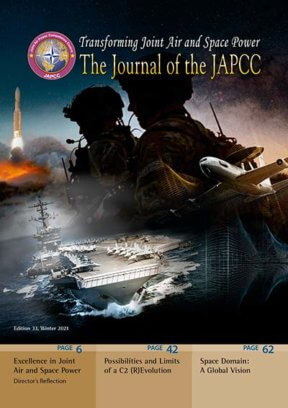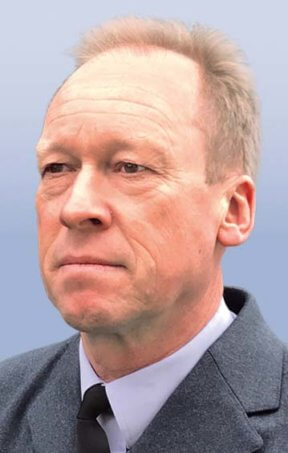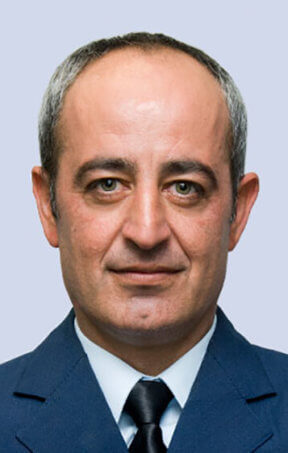Introduction
In ‘The History of the Peloponnesian War’, the ancient Greek philosopher-historian Thucydides charted the war events which took place between Athens and Sparta (431–404 BC). One of the most significant parts is the ‘Melian dialogue’1, where representatives of Athens and Melos negotiate the submission of the Melos Island. During the dialogue, the Athenian envoys asserted ‘since you know as well as we do, that right, as the world goes, is only in question between equal powers, while the strong do what they can and the weak suffer what they must.’
Russia’s aggressive 2008 campaign against Georgia and the 2014 annexation of Crimea echo Thucydides’ Athenians. Its ongoing deployment of Anti-Access/Area Denial (A2/AD) capabilities, with offensive and defensive, multi-layered, electromagnetic interference-resistant, cross-networked Integrated Air Defence System (IADS) zones only furthers this message. By preventing enemy combat aircraft from taking advantage of the Freedom of Manoeuvre (FoM), Russia has asserted that it too will do what it can and the weak will suffer what they must.
A2/AD – The Threat
Although there is much debate over the term A2/AD,2 it is a useful way to describe the effects of a critical Russian (and Chinese) concept, strategy, and capability. According to the United States (US) Joint Operational Access Concept,3 the following two terms are defined as:
Anti-Access: those actions and capabilities, usually long-range, designed to prevent an opposing force from entering an operational area. Anti–Access actions tend to target forces approaching by Air and Sea, but can also target the Cyberspace,4 Space, and other forces that support them.
Area-Denial: those actions and capabilities, usually of shorter range, designed not to keep an opposing force out but to limit its freedom of action within the operational area. Area Denial capabilities target forces in all domains.
Our adversaries generated this A2/AD environment to deter/defend against NATO reactions, inflict an unacceptable political, military, and civilian cost to the Alliance and hence force a negotiated settlement with more favourable terms for their sides. They created these geographically specific zones to support their geopolitical objectives.
Russian and Chinese A2/AD capabilities5 span many platforms and multiple domains to generate these effects against the Alliance. Some major categories of capabilities fall under the heading of missiles (cruise and ballistic), IADS, fighter aircraft, submarines, Special Forces, and other non-kinetic assets. A modern A2/AD concept will simultaneously employ many effects across multiple domains to prevent NATO forces from entering and operating within a specific area. It will use asymmetric methods with non-kinetic assets to deny access to the Space and Cyberspace domains and the Electromagnetic Spectrum to dominate the physical domains. Thus, A2/AD environments are comprised of a system of systems, which overlap and complement each other, mitigating the weaknesses of each and thus making it very difficult to attack any part without another part countering the attack.
When faced with such a system, we discover that it is designed to be difficult to counter. NATO’s adversaries have observed the western way of warfare over the past 30 years. They have had time and opportunities to analyse our weaknesses. One factor has been the west’s (and NATO’s) leverage of superior airpower, giving all our components FoM in all domains. The adversaries did not try to match NATO’s battle-winning technology for their air assets and, instead, focused on developing the Surface-Based Air Defence (SBAD) field.6 This approach led to advanced IADS and, subsequently, the A2/AD system. A2/AD threatens NATO FoM in all domains; being designed to cause joint problems, it can only be countered with a joint solution. It is also intended to cause ‘wicked problems’,7 in such a way that while solving one aspect of the problem, another becomes critical. This partly happens because, while we talk about a joint fight in NATO, the component-based Joint Task Force is mainly structured to take care of its own component business. Whilst we are set-up to exploit opportunities created by other elements, our cross-component integration is rudimentary. Moreover, employment of Joint Fires is simply not understood enough within the Alliance to exploit its true potential.
A2/AD – Combating the Threat
NATO uses a well-defined F2T2EA8 targeting cycle and has some very advanced platforms designed to carry it out. However, traditionally, the Find function has fallen to the wide-bodied Intelligence, Surveillance and Reconnaissance (ISR) air assets, such as the RC 135 Rivet Joint or the E8 JSTARS. Used in combination with other ISR capabilities, these platforms can detect and track threat systems’ movements – which is particularly important considering the mobility of many parts of an A2/AD system. The newer problem is the increased range of these threat systems; they can hold the large ISR assets at risk at ranges of hundreds of kilometres, thus inhibiting their ability and accuracy in performing their F2T2 functions. One solution to this problem came with the advent of low-observable 5th Generation (G5) combat aircraft. They bring step advances in the traditional combat air sphere while also providing sensor suites to rival traditional ISR platforms. However, the unique design of G5 platforms makes the weapon load capacity less than that of the 4th Generation (G4) combat aircraft.
The drawback is that the G5 platforms can position themselves to find, fix, and track advanced targets but do not have the appropriate weapons to engage all targets, if they use their low-observable capabilities.9,10 Conversely, the G4 platforms can carry appropriate weapons but cannot get close enough to employ them. Furthermore, G4 platforms cannot use Long-Range Stand-Off Weapons (LRSOW), as the targets in the threat system are highly mobile while the comprehensive planning required for LRSOW employment is not flexible enough.11 Even the GPS-reliant Joint Air-to-Surface Standoff Missile (JASSM), which can be re-programmed in the air, when launched in an attack on coordinates mode can be easily jammed.12 What is needed is the ability of the G5 platforms to provide the F2T2 service to a flexible and highly reactive weapon system that can be effectively and rapidly employed without itself becoming vulnerable to the threat.
Having examined what makes up an A2/AD environment, we shall focus on the methodology required to defeat it and how it fits within the current doctrine. As we have seen, A2/AD is a joint problem, threatening all domains.
One effective solution is the employment of joint capabilities, enabling a layered approach. Just as the A2/AD is a layered and overlapping set of threats, the way to combat it lies in the use of joint effects that complement each other in degrading the A2/AD whilst negating the threat to themselves. This may mean, for example, that the sensor and shooter in the kill chain are different actors. This is entirely coherent with the NATO Joint All-Domains Operations (JADO).13
The JADO approach14 presents its own set of challenges; leveraging joint effects requires close cross-component and joint coordination to a higher level than we routinely practice in NATO. However, the increasing complexity of A2/AD and the necessity to use joint effects to counter it means that the development of this doctrine is essential. Various attempts modelled to degrade A2/AD, using conventional Suppression of Enemy Air Defences (SEAD) operations, have consistently shown that the requirement in ordnance when the Air Component attempts it alone is prohibitive. For a realistic chance of success we need to synchronize Joint effects.15,16
An ability to understand how and why to synchronize joint effects is needed. Still, one of the limiting factors is our ability to share information with the correct classification between components and units (sensor to the shooter) at the speed of relevance.17 This becomes a crucial limiting factor when we must rely, for example, on a G5 platform finding and fixing a long-range Surface-to-Air Missile site but a Land Component Surface-to-Surface Missile battery is acting as the kill mechanism.
Synchronizing the Joint Effects in Action
So much for the theory. How about the practice? The synchronization of joint effects to counter A2/AD problems has been introduced in recent NATO exercises. The first exercise approached the problem with a ‘Tiger Team’ mentality. It quickly became apparent that the expertise and understanding needed for this function required a specialized team. This led to the implementation of the Joint Effects Synchronization Team (JEST) in subsequent exercises. The JEST brought together strategic planners, targeteers, and Subject Matter Experts (SMEs) from G5 aircraft, cyberspace, space, and Electronic Warfare (EW) backgrounds, all focused on defeating the A2/AD threat. Formalizing the team also meant that the A2/AD problem could be worked outside of the traditional 72-hour Air Tasking Order cycle, which is critical because many of the required capabilities have longer lead times to coordinate and benefit from the conditions-based approach of the Strategy Division. This became especially apparent with the inclusion of LRSOW in the counter A2/AD package. While unsuited against all A2/AD threats, LRSOW are capable against certain fixed targets and can be used to expose other A2/AD elements. Employing a 96–120 hour planning horizon allowed more effective synchronization of LRSOW with the traditional strike assets and also enabled similar harmonization of effects from other domains including space, cyberspace, and EW.
Wicked problems, like the A2/AD, can only be tackled through joint, synchronized effects in space and time. Therefore, before the operation (exercise) even started, the JEST developed a broad-brush plan to break the A2/AD into separate elements enabling a comprehensive approach. Ideally, in such a plan each critical target would be addressed with multiple lethal and non-lethal effects, from multiple kinetic and non-kinetic providers from all appropriate domains.18 Achieving this harmonization requires a JEST populated with members that have a strong understanding of joint capabilities, which enables detailed coordination with the other components’ joint fires SMEs. HQ AIRCOM was fortunate while developing the JEST to have a good working relationship with US Air Forces Europe 603rd Air Operation Center (AOC) Targeting Effects Team and with US European Command’s Joint Fires Cell, which enabled rapid process improvement.
While the JEST function is joint by doctrine, and should ideally reside with the Joint Force Commander, the extensive and unusual skills required to plan an A2/AD takedown led AIRCOM to develop an effects integration capability like no other. Thus, with Allied Joint Force Command Brunssum’s (JFCBS) agreement, the JEST has continued to reside within the AIRCOM Joint Force Air Component (JFAC) while executing with JFCBS’s authority. This clarification of role versus authority was essential to acceptance by the other HQs and was recognized as necessary to address the A2/AD threat. Countering A2/AD threats requires a considerable effort and, if left unaddressed, can lead to other components not receiving the expected level of air support. All components must understand that without tackling the A2/AD threat, the Air Component will not have the FoM needed to provide that air support.
Key Takeaways
The application of this process in the aforementioned exercises allowed for its refinement and improvement while identifying some key takeaways:
- A2/AD systems can only be tackled from a joint approach.
- All components have a vested interest in successfully degrading the A2/AD system.
- The need to increase knowledge across all components of the entire spectrum of joint capabilities and the whole F2T2EA process, and to understand each element’s contribution.
- The need to improve the sensor-to-shooter communications process, particularly given that these will frequently occur across components. Compatible and secure communication systems are crucial.
- The Alliance needs more Joint-fires and effects experts. Understanding joint effects at the Component HQ level is lacking; without this expertise, we struggle to achieve the synchronization required to combat the A2/AD threat.
Conclusion
In many ways, the advent of A2/AD threats and the development of methods to counter them are nothing more than the latest iteration of the cavalry being replaced by observation balloons. A2/AD can hinder our ability to ‘see over the hill’. We owe it to our front line troops to perfect ways to see what the enemy is doing and influence him. Unlocking the A2/AD problem is key to this and we must continue to perfect the processes we have developed so far, coherent with NATO’s JADO concept.
This way, the Alliance can be transformed and prepared for the future challenges of the modern battlespace. Training, education, and future leadership can enhance all aspects of Joint All-Domain warfare, confirming the consistency of Thucydides’ words: ‘In practice, we always base our preparations against an enemy on the assumption that his plans are good; indeed, it is right to rest our hopes not on a belief in his blunders, but on the soundness of our provisions. Nor ought we to believe that there is much difference between man and man but to think that the superiority lies with him who is reared in the severest school.’19









